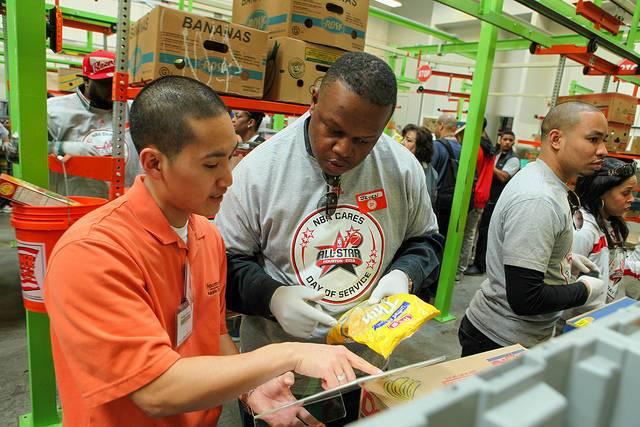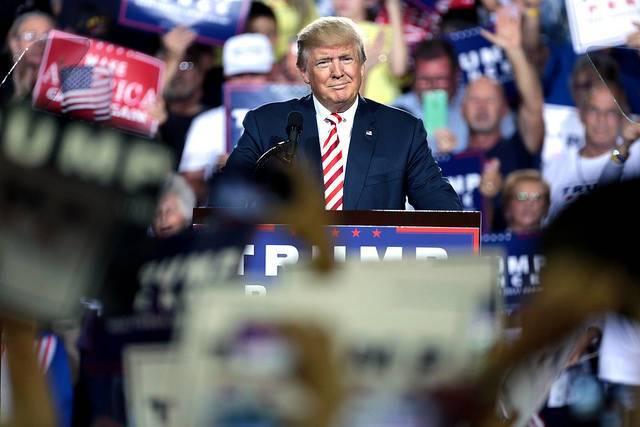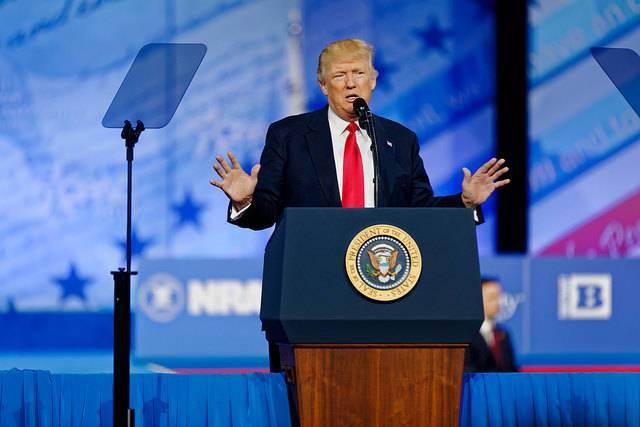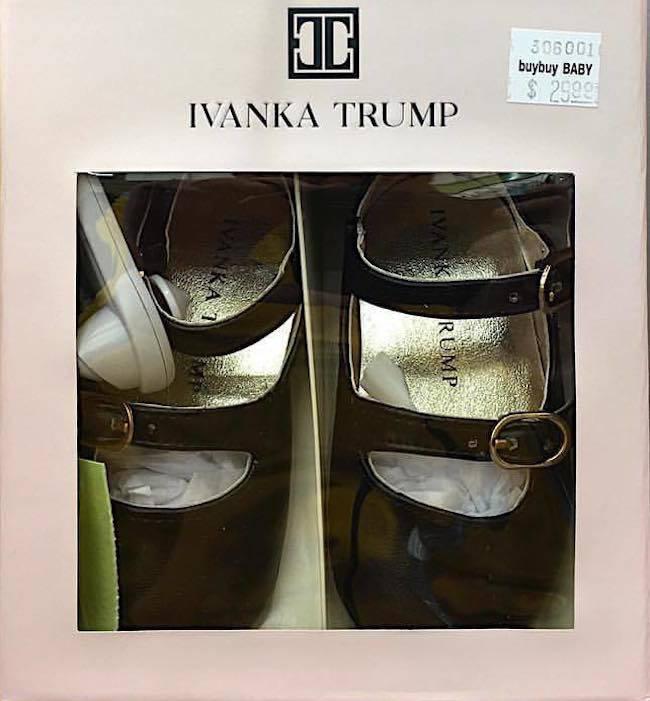Trump Budget Swings Heavy Hammer at Federal Agencies


As more information about the Donald Trump administration’s budget -- and proposed cuts to a swath of agencies in order to bolster military spending -- hit the newswires, it is clear environmental protection and climate change mitigation are not the only targets.
Trump’s proposed cuts also include programs ranging from Meals on Wheels to cancer research. But describing this list of cuts as simply “in addition to” does not quite tell the story. The reality is that the challenges presented by climate volatility, environmental justice and public health are all intertwined.
Take the proposed cuts to the Department of Health and Human Services (HHS). Much of that ax would fall on the National Institutes of Health (NIH), an agency that over the years has benefited from considerable bipartisan support. As the Los Angeles Times reported, the White House’s “skinny budget,” which seeks to stamp out non-defense discretionary spending, would slash NIH funding by $5.8 billion next fiscal year.
Other agencies that fall under the HHS umbrella, including the Centers for Disease Control and Prevention (CDC), would see funds diverted to block grants that would be distributed to individual state governments.
Both organizations have focused on climate change and its relationship to public health. The NIH still describes climate change as a “a critical health problem,” while the CDC linkes a bevy of health problems to the the world’s evolving climate.
NGOs focused on public health and disease have responded to Trump’s budget with alarm. Harold Wimmer, president and CEO of the American Lung Association, said in a public statement:
“NDD programs – including critical public health programs at EPA and the CDC – have been subject to repeated cuts over the past six years, including through the appropriations caps and sequestration process established by the 2011 Budget Control Act.Environmental NGOs have also been quick to point out the links between environmental protection, public health and national security."The cuts proposed in this 'skinny budget' will starve our nation's biomedical research and public health infrastructure. While the blueprint released by the President is short on details, it clearly threatens the lung health of our nation. Congress must reject this budget and start anew with a balanced approach that protects vital health programs in HHS and at EPA.”
“The latest budget continues the administration’s shocking disregard for priorities that are critical for people’s health and the economy,” Manish Bapna of the World Resources Institute told TriplePundit in an email. “The U.S. government must have the resources to protect air, water and people’s health at home [and] have the tools to advance U.S. diplomatic and strategic interests overseas.”
Also on the chopping block is foreign aid, on which less than 1 percent of the U.S. federal budget is spent year to year.
Along with diplomacy and military might, national security experts have long argued that foreign aid is another tool in the U.S. government’s kit to guarantee safety here and abroad. Some of those funds are dispersed to organizations such as the World Bank and International Monetary Fund, and programs that address climate change and public health are included in their mandates. But as the New York Times reported, the World Bank will see its U.S. contribution slashed by $650 million. The Trump White House says it wants those line items “refocused” on nations of “strategic importance” to the U.S.
Justin Sink and Erik Wasson of Bloomberg argued that the Trump budget plan is based more on a personal vendetta than a thoughtful outlook on domestic and foreign policy, pointing out that Trump “derided” many of those agencies and programs during his campaign.
Also hit hard, not surprisingly, will be the State Department’s budget, which in recent years expanded to include programs related to public health, particularly HIV/AIDS funding, as well as other programs and offices linked to climate change. Foggy Bottom could see its funding crater by 28 percent. In an email to employees, Secretary of State Rex Tillerson said such cuts are necessary to make way for the administration’s “unmistakable restatement” of the country’s new priorities.
After 70 years as “leader of the free world,” this budget reflects a massive shift in America’s priorities.
Where many critics of this country see a military and diplomatic bully, others have always seen the U.S. as the adult in the room, which in this case is Planet Earth. Even during the George W. Bush administration and the controversy over two wars overseas, the younger Bush created his fair share of goodwill with his presidency’s global battle to fight AIDS and his work on women’s empowerment, both of which have continued in various forms after his presidency.
But times are changing, and that worries some of the world’s foremost organization that focus on the global poor.
“This budget is a narrow-minded and small-hearted reimagining of America’s role in the world,” Raymond C. Offenheiser, president of Oxfam America, told 3p in an email.
“Since the Second World War, presidents of both major parties advanced U.S. interests by working to strengthen international security, end global poverty, and deepen diplomatic and cultural ties with people around the world. That tradition has bolstered American leadership in the world, but it would come to an abrupt end if Congress follows the Trump administration’s callous blueprint.”
Image credit: NIH/Flickr
Your Funding Was Cut . . . Now What?


By Joanne Sonenshine
On the heels of Thursday’s revelations about President Donald Trump’s reductions in foreign aid, environmental programs and diplomatic funding, clients have asked me what to do now.
For many nonprofits, and even some companies, federal funding constitutes half of an annual operating budget. Aid programs that improve the state of women’s health, childhood nutrition and security are among those that could be cut. Certain federally-funded programs, like USAID’s Feed the Future or USDA’s Food for Progress, are necessary to ensure we, in the United States, have access to healthy food to serve our families and ourselves. Additionally, federally-funded programs help build diplomatic capital -- or, in other words, ensure other countries have development infrastructure to advance and succeed, encouraging global economic prosperity and halting excess migration. These programs are critical, and a reduction in funding will be devastating.
Any nonprofit budget officer knows that an announcement of this magnitude must be met with months of preparation, forecasting different scenarios to avoid program shortfalls and quick delivery of replacement funding to ensure constituents relying upon this critical funding for shelter, food aid, access to water, security and education are not hurt by such cuts.
Seeking new funding sources, and considering alternative partnership scenarios, will be critical to ensure nonprofits, companies relying on federal funding, and other organizations impacted by massive federal funding cuts stay afloat.
My recommendations are as follows:
1. Find your place among the risks
As I have written about before, companies are increasingly mitigating risks throughout their operations and supply chains, partially to ameliorate bad press, but also because it makes good business sense.
Finding causes that support business decisions aligned with profit is a trend here to stay. Companies across the sector spectrum -- from food and agriculture, to consumer goods, to apparel to manufacturing -- are finding ways to “do well by doing good.”
Take this week's news that General Mills, the maker of Cheerios, plans to give away 100 million wildflower seeds to anyone willing to plant them. This initiative, in partnership with a medium-sized organic seed company, is meant to #BringBackTheBees, which play a critical role regulating our food supply.
General Mills recognizes that without pollinators, their costs of doing business -- and sourcing honey as it grows increasingly scant -- will be overly expensive. This effort to bring back the bees makes good business sense for General Mills. It is a win-win, as it also improves our environment and natural resources at the same time.
Identifying solutions that add value to a big company, and helping them mitigate risks within their operational frameworks, will be a helpful way to add corporate funding to a nonprofit or small for-profit budget.
2. Partner for a cause
The number of social enterprises (companies that seek a profit while also giving back to improve social capital) has risen dramatically over the last decade. There is even a Social Enterprise Alliance, helping social entrepreneurs gain valuable skills to succeed and thrive, both in mission and in profit.
Social enterprises are often initiated with an idea that can both shift the traditional consumption market and make a difference. Inherent in a social enterprise model is therefore a need to give back to causes that deliver on the enterprise’s mission.
Many social enterprises are filling the natural products space, for example. At their annual Expo held last week in Anaheim, California, it seemed almost every brand had a cause with which it associated, leading marketers to scramble to catch up. In an article for FoodDive, Emma Liem listed “brand missions” as one of four key marketing trends for natural food products -- and, accordingly, that will mean a need to find partners to deliver on those causes.
Identifying ways to partner with social enterprises that align with a nonprofit mission or cause will amplify opportunities for funding.
3. Collaborate around big money
In 2015 the MacArthur Foundation decided to “retool“ its grant-making efforts. As I reported at the time, foundations are becoming more proactive with their funding. Several big foundations no longer accept unsolicited proposals, and the number of funding categories is shrinking.This means that while nonprofits and other funding recipients should still count on foundation funding for the time being, they will need to be more innovative and efficient in their outreach and approaches.
Coming to the table with a multi-faceted, collaborative concept to solving a problem posed by the foundation will be appreciated. This means that nonprofits may consider joining forces with complimentary nonprofits, reducing the costs of delivery, and being forthcoming around comparative advantage opportunities.
Likewise, a nonprofit may approach one of its private-sector partners to pose unique funding leverage scenarios to a foundation, built around existing programs of work that need scaling.
There are ample ways to identify prospective partners whose end game is the same, but whose approach may be a bit different. Making it easy for a foundation to fund this type of partnership by laying out the collective action born of the collaboration is key.
4. Pledge allegiance to our flag (and others)
While the U.S. government may trim its support in areas of influence for aid practitioners and those working in environmental conservation, other governments may step up to fill in the gap.
For example, Canada agreed to “plug the gap” after President Trump eliminated federal funding for global women’s rights programs by an increase of $650 million. Other governments have accessible funding programs, as well, that are open to international nonprofits and social organizations. The U.K. government recently announced funding increases to aid programs globally, as well as a more streamlined approach to dispersing funding so it is more accessible and impactful.
Finding opportunities to pair nonprofit (or for-profit) delivery mechanisms with other governments' budgets may be time consuming, but it will be worth it if it means more funding for existing and newly designed projects.
Do not discount the U.S. government, however, even with reduced funding. Reductions in certain program funding may be temporary. And even for those that are longer-term, we are facing a time where we must do more with less, be efficient and creative, and push our government to keep funding flowing where it is most needed – to help those that cannot help themselves.
Image credit: Flickr/State Farm
Joanne Sonenshine is Founder + CEO of Connective Impact, aiding organizations in strategic goal development, partnership creation, coalition building and collective thinking in order to solve some of the most complex problems of our time. Immediately prior to launching Connective Impact in January 2014, Joanne was a Director at Conservation International where she managed programs focused on climate mitigation and adaptation, climate smart agriculture, responsible sourcing and effective land use. Joanne is a trained development economist and has been living and working in the Washington, DC area for eleven years. Her professional experiences have included working at the U.S. Department of Commerce International Trade Association and as a registered lobbyist advocating for more comprehensive environmental sustainability regulations.
Trump Administration Will Review Obama-Era Fuel Efficiency Standards


During a visit to Michigan earlier this week, U.S. President Donald Trump said his administration “will work tirelessly to eliminate the industry-killing regulations, to lower the job crushing taxes and to ensure a level playing field for all American companies and workers.”
And he plans to move closer to fulfilling that promise. While Trump was in Detroit, his administration announced that it will task the Environmental Protection Agency and the National Highway Traffic Safety Administration (NHTSA) with reviewing vehicle fuel-efficiency standards bolstered under former President Barack Obama.
The Corporate Average Fuel Economy (CAFE) standard was first introduced in 1975. In 2010, the Obama administration added fuel-efficiency standards that mandated cars average over 54.5 miles per gallon (mpg) by 2025. The Obama administration also developed a national program for greenhouse gas (GHG) emissions for light-duty vehicles (passenger cars and trucks).
Before Obama left office, then-EPA Administrator Gina McCarthy finalized both the CAFE and GHG vehicle standards. She said she based her decision “on the technical record created by over eight years of research, hundreds of published reports, including an independent review by the National Academy of Sciences, hundreds of stakeholder meetings, and multiple opportunities for the public and the industry to provide input.” She added that the analysis of the standards “has shown that the greenhouse gas emissions standards for cars and light trucks remain affordable and effective through 2025, and will save American drivers billions of dollars at the pump while protecting our health and the environment.”
Speaking about McCarthy’s finalization of both standards, Trump said the Obama administration “broke its promise to automakers and rushed the midterm evaluation to a premature conclusion earlier this year.” He claimed that reinstating the midterm evaluation -- which, among other things, analyzes automakers' ability to comply with the standard -- “ensures that regulators will rely on the best available data and information, which the previous administration ignored.”
By reviewing the standards, Trump says his administration “will examine, and if necessary, revise, the regulations on auto manufacturers and the attendant costs passed on to consumers."
The standards are expected to bring great benefits to both the environment and the economy, the EPA reports on its website. The agency projects the two standards will cut 6 billion metric tons of GHG emissions over the lifetimes of vehicles sold in model years 2012 to 2025. They will also save Americans more than $1.7 trillion in fuel costs and reduce the nation’s dependence on oil by over 2 million barrels per day in 2025, according to the EPA.
The World Resources Institute quickly came out in support of the vehicle standards, saying they actually allow U.S. automakers to stay competitive.
When Obama took office, the American automobile industry was in dire straits, and two of the Big Three automakers took government bailouts to stay solvent. For seven years, the industry experienced “sales gains, growing jobs, and increased innovation, while also meeting more stringent standards,” Kristin Igusky of the WRI wrote in a blog post on Tuesday. If the current vehicle standards are weakened, she argued, it “could put our competitive advantage in the global economy at risk.”
Other countries, including Japan and nations in the European Union, have either existing or proposed fuel-efficiency standards that compare to the 2025 U.S. rule.
Efficiency rules have been relaxed before, as Fortune's Margo Oge points out. When efficiency rules were relaxed in the mid-1980s, foreign automakers only had about 25 percent of the market, but now they have 55 percent.
“Repealing existing standards once again will not only set back efforts to mitigate climate change, undermine the consumers pocketbook, and cost jobs, but it will again set America’s auto companies on a collision course,” Oge reported.
Other environmental groups also defended the standards. “Mileage standards save consumers money at the gas pump, make Americans less dependent on oil, reduce carbon pollution and advance innovation,” Rhea Suh, president of the Natural Resources Defense Council (NRDC), said in a statement.
She argued that the current standards “helped the auto companies move from bankruptcy to profitability, and there is no reason they cannot be met.”
“Our cars and trucks are not nearly as clean as they should be, but they're a lot cleaner than they used to be -- more than 40 percent less polluting than they were 20 years ago,” added Michelle Kinman, clean energy advocate for Environment California.“America should be putting cars that burn too much gasoline in the rear-view mirror. Unfortunately, EPA’s order today is a green light to keep making cars that dirty our air, endanger our health and threaten our children's future.”
The vehicle standards put into place under the Obama administration benefit both the American people and the environment. If the Trump administration decides to weaken them, both will suffer.
Image credit: Flickr/Gage Skidmore
CVS, Novo Nordisk Partner to Make Insulin More Affordable


To put it mildly, prescription drug prices are surging.
Some of the most egregious examples of price-gouging fueled anger that help buoy U.S. Sen. Bernie Sanders’ insurgent presidential campaign last year. Absurdities such as laws that prohibit Medicare and other healthcare programs from negotiating drug prices explain the constant increase in the cost of pharmaceuticals, though some analysts say the dynamics between industry, healthcare providers and government indicate that changing these policies change may not necessarily work.
Other tactics, such as a more stringent enforcement of U.S. patent law, have been suggested in Congress. Even President Donald Trump called for action on skyrocketing drug costs – though his fractious relationship with Congress could get in the way of significant change at the policy level.
But at a time when advertising revenues on television are stagnant or even declining, pharmaceutical companies continue to spend billions on commercials – and it's fueling the rise in drug prices. Despite the drug companies’ insistence that they need to charge these prices to cover their research and development costs, Ana Swanson of the Washington Post argued two years ago that 9 out of 10 large pharmaceutical firms spent more on marketing than scientific research. Watch television during one of the few remaining soap operas or the networks’ evening news, and the evidence suggests those trends have not budged much.
Nevertheless, public pressure and outrage could nudge more companies to become more conscious about their impact on public health, notably by changing how they market and price some of the most needed drugs on the marketplace.
To that end, two companies -- a retailer and drug manufacturer -- are seeking to capitalize on American patients’ growing angst.
On Thursday, Novo Nordisk and CVS Health announced a new savings program that would offer immediate discounts on several medications. Diabetes drugs -- including insulin brands Novolin R, Novolin N and Novolin 70/30 -- will be sold for $25 per 10-milliliter vial. Novo Nordisk says this could result in savings up to $100 per purchase for patients who do not benefit from a pharmaceutical drug coverage plan.
Those drugs will be available at over 67,000 retail stores, including at CVS drugstore and Target locations.
If scale and consumer reach can turn an industry around, then watch for Novo Nordisk’s competitors to follow suit. One study suggested that the cost of insulin more than tripled in the U.S. between 2003 and 2013.
Concern over insulin’s affordability led to one lawsuit, accusing three insulin makers of price-fixing, to be filed in a Massachusetts federal court in January. Novo Nordisk, Sanofy and Lilly were named in the litigation, which alleges those companies violated the 1970 federal Racketeer Influenced and Corrupt Organizations Act. Novo Nordisk's stock price slumped 5 percent since the lawsuit was filed and remains stagnant. Rebuilding consumer trust could help the company improve its reputation as well as the performance of its stock shares.
Meanwhile, CVS appears to have remained above the fray as consumers and politicians demand accountability from drug companies. In fact, the retail chain’s partnership with Novo Nordisk is another step in what CVS says is its work to keep the price of pharmaceuticals affordable.
In a progress report issued earlier this week, CVS says customers of its benefit management program saw overall costs increase by only 3.2 percent between 2015 and 2016, the smallest uptick in four years. Furthermore, the company claimed 38 percent of its customers actually saw a reduction in pharmaceutical drug spending.
With at least 29 million Americans dealing with diabetes and 6 million of them regularly taking insulin, CVS is on track to see that trend repeat at the end of 2017.
Image credit: Brian J. Matis/Flickr
Iceland Considers Tourism Tax to Cope with Flood of Visitors


Despite its geographic location, Iceland is hot -- well, at least in the figurative sense: This country, slightly smaller than Kentucky, has emerged as a popular holiday destination for global travelers.
This can be partially attributed to the success of its national air carrier, Icelandair, which since the 1960s has allowed passengers to stopover in the isolated North Atlantic country for as long as week. The airliner’s competitive fares allow college students to do the train-and-hostel trips of their dreams while enabling other travelers navigating either side of the Atlantic to make their vacation or business trip even more exotic.
Tourism has been part of the revitalization of Iceland’s economy, which cratered during last decade’s fiscal crises. But the country recovered, despite the fact that 97 percent of its banking industry collapsed in a few days. Only this month were the country’s strict capital controls finally lifted.
In short: Iceland is on a high, and its economic nightmare seems ages ago. The infamous eruption of the Eyjafjallajökull volcano, which disrupted global air travel in the summer of 2010, at first worried local tourism officials as Iceland was still on a slow path to recovery. As Tim Moore argued in the Financial Times, the opposite proved true as potential visitors became much more interested. Budget airlines seized on the trend, as well as cheap landing fees at the international airport serving Reykjavík, the country’s capital.
But as Bloomberg reported on Thursday, tourism has also imposed its own stress on the country.
Home to only 323,000 people, Iceland is on course to host 2.3 million travelers this year, almost a five-fold increase from the half a million people who visited in 2010. The nation is home to fascinating topography and a bounty of icebergs and glaciers -- not to mention the opportunity to visit scenes from the HBO series “Game of Thrones.” And the droves of visitors nudged the country to develop a new master plan for Reykjavík’s airport.
Today, travelers are exempt from many of the taxes imposed on Iceland’s citizens and residents, but that began to change earlier this year, and some taxes are now levied at a discounted rate. And that may continue.
For now, the country’s coalition government is at the earliest stages of sorting out the details, Bloomberg’s Omar Valdimarsson explained. Hotel taxes could increase, tour guides and transport services may be subjected to new fees, or both visitors and locals may be required to purchase an annual “nature pass." Similar ideas proposed within Iceland's parliament in the past, however, have failed.
Some Icelanders argue that such taxes are needed to strengthen the country’s infrastructure and cope with the threats of environmental degradation.
Outside of Reykjavík, much of the country is ill-equipped to handle the influx of visitors. The result is an explosion in growth for services such as Airbnb, which became the target of legislators as more residents seek to benefit from the country’s tourism boom. One recent report suggested bookings on the popular room-sharing site more than doubled over the previous year. Icelandic officials have since imposed a value-added tax on Airbnb stays as the number of rooms available for the service exceeds the total hotel rooms available in the country.
Everyone wants a slice of Iceland’s tourism pie. The country’s economy expanded 7.2 percent last year – a rate unheard of in Europe. But Icelanders are wondering if they should welcome this heady growth, and at what cost.
Image credit: Moyan Brenn/Flickr
Protests Mount Against Trump's Proposed Domestic Spending Cuts


U.S. President Donald Trump’s proposed budget for fiscal year 2018 is out, and it is every bit as devastating to federal agencies as anticipated. It calls for a $54 billion increase in defense spending in 2018 that will be “offset by targeted reductions elsewhere.” The departments of Defense and Homeland Security will receive funding increases, while every other agency faces massive cuts.
Independent agencies supporting the arts, development groups and public broadcasting would be eliminated. The list includes the Corporation for Public Broadcasting (CBP), which funds PBS and public radio stations through grants. In 2014, the CPB gave $74.63 million for television programming which included popular shows like "Frontline" and "NewsHour," according to the Poynter Institute.
The CPB also funds journalism and has invested over $27 million since 2009 to help launch 113 public media stations in 40 states.
“There is no viable substitute for federal funding that ensures Americans have universal access to public media’s educational and informational programming and services,” Patricia Harrison, president and CEO of the CPB, said in a statement.Earlier this week, Damian Paletta of the Washington Post warned that a budget like this may end up causing a “historic contraction of the federal workforce.” And that could mean federal agencies will not be able to do all that they are tasked with doing, causing them to cut programs. Impacted agencies include NASA and the National Oceanic and Atmospheric Administration (NOAA).Eliminating federal funding to the CPB “would initially devastate and ultimately destroy public media’s role in early childhood education, public safety, connecting citizens to our history, and promoting civil discussions,” she added.
Some Florida scientists are so concerned about the proposed budget cuts that they wrote a letter to Trump and asked him to reconsider.
In the open letter, they reminded the president that “American scientists have historically been at the forefront of scientific discoveries and innovation.” As a result, the nation needs to “invest heavily in our effort to understand our home planet and be aware of how physical changes will impact industry and society.” They say both NASA and NOAA support such research and are “crucial to our ability to predict extreme weather.”
The scientists also claim these agencies help create jobs and have a “huge impact on our economy, and ultimately generate the technologies that make America great.”
Earth science programs support diverse research, including monitoring and analzing soil changes and water resources, and tracking conditions that affect the food and medicines obtained from the ocean. All of these activities are vital to the American economy.
The scientists encouraged Trump to do the following as he considers spending allocations:
- Continue earth science research, including funding for NOAA’s environmental satellites and NASA’s new technologies that measure the vital signs of the planet.
- Preserve scientific integrity by not allowing politics to interfere with the information shared with the public.
- Recognize coastal properties that are at risk from rising sea level.
A coalition from the coal industry, energy associations and labor unions is also speaking out about the proposed budget.
In another open letter, they asked Trump to preserve funding for the Department of Energy’s (DOE) Office of Fossil Energy, which studies technologies such as carbon capture and storage.
They cited a public-private partnership as an example of the department's success: The Petro Nova project at a coal-fired power plant in Texas will be the largest carbon capture initiative in the world. Rather than being emitted into the atmosphere, the captured carbon is used in nearby oil fields, helping to produce 75 million barrels of oil. “Thanks to smart federal and private investments, the project is on time and on budget,” the letter states.
Democratic lawmakers are unsurprisingly also displeased with the budget. And some Republican lawmakers expressed their concern before it was even released. Sen. Lindsey Graham (R-S.C.) said the president’s budget “is dead on arrival” and “would be a disaster.” Back in January, Sen. Lamar Alexander (R-Tenn.), senior member of the Appropriations Committee and chairman of the Health, Education, Labor and Pensions Committee, said: “Any effort to balance the budget by cutting discretionary spending is not a straightforward approach.”
Now that the proposed budget has been released, even more lawmakers are speaking out. Some Republicans took issue with cuts to programs that benefit their constituents. Speaking about cuts to a program that benefits the Great Lakes, Sen. Rob Portman (R-Ohio) said: “I’m committed to continuing to do everything I can to protect and preserve Lake Erie, including preserving this critical program and its funding.”
Rep. Charlie Dent (R-Penn.), who also sits on the Appropriations Committee, added: “We can’t finance a defense buildup entirely on the back of domestic, non-defense spending. It’s not realistic and unfair.” He explained that while the president proposes a budget, the Congress disposes it. In other words, Congress controls the purse strings.
The initial congressional reaction may just be a sign of what’s to come. Or as Lisa Mascaro of the Los Angeles Times put it: “The reaction illustrated why, despite the significant attention they are drawing, Trump's proposed dramatic cuts will likely be scaled back, changed or eliminated altogether.”
Image credit: Flickr/Michael Vadon
Austin's New 'Stationless' Bike-Share Program Lets You Park Anywhere


Think of it as a flexible car-share program on two wheels.
One of the best things about ridesharing programs is the range of choices – including when it comes to reserving a vehicle that happens to be right outside your door. There’s no need to hoof it to the “nearby” lot or spend 20 minutes filling out lengthy forms each time you want to rent a car. There’s an app for that.
Well, the same principle is now available for bikes in Austin, Texas. The Spin bike-share program, which launched after a detailed study of successful programs in other cities, operates on a stationless bike concept -- allowing riders to reserve a bike online, use it wherever it’s available within city limits, and then drop it off and lock it to any publicly-accessible bike rack.
It’s a popular concept in places like China, where bike-share companies have been successful in raising large amounts of capital to support new, widely-used programs. Here in the States and Canada, however, the idea that a bike can be rented and left anywhere for the next guy is still a novel (if not scary) prospect for investors.
The architect of this new program, Derrick Ko -- who, coincidentally, used to work for Lyft, and is familiar with the elements that make a car-share program so popular -- says the company studied a number of other bike-share programs before launching in Austin earlier this month. The company celebrated its first day in Austin with a post on Medium:
Research shows that station-based programs in places like the San Francisco Bay Area, Seattle and Boston often suffered from under use, Ko told FastCoExist. A bike in the Bay Area is used an average of 1.7 times a day. The new company figured this statistic could be improved if cyclists weren’t as restricted in where they picked up, used and dropped off the bikes – what Ko called an “unnatural” pattern of behavior for city-dwellers who are used to going from point-to-point quickly, often in short jaunts.
And it’s wasteful -- the very problem the sharing economy railed against when it first launched a decade ago. It forces consumers to choose cars over bikes for those trips that are just plain miserably inconvenient (or too expensive) to make by bike, like heading to a neighborhood that doesn’t have a bike drop-off point.
What I find makes sense about Spin’s strategy is something often left out of the equation: It’s inclusive. I’d be willing to bet that conventional station-based bike programs are passed up by people who can ride a bike but have limited walking capacity, like individuals with disabilities.
Our past reviews of global bike-share programs highlighted this: Stations were often positioned in areas that benefited from the greatest volume of consumers (and fit ones at that), not necessarily where consumers needed to go. So, hoofing six blocks to pick up a bike would be a turnoff for an individual who finds it uncomfortable to walk that distance.
But the big surprise is the cost. According to Spin’s research, it's actually far more expensive to set up and maintain a station-based bike program compared to a stationless one – five times more expensive, to be exact.
Ko said the concept encourages cities to invest in bike racks (something many cities already do), but doesn’t require the massive outlay of investment that has been seen in New York or Toronto bike-share programs.
The concept does require the company to have staff on hand (night and day) to periodically retrieve and reposition bikes that are left in less-popular locations, and Ko didn’t say whether that overhead was factored into cost comparisons.
On its website, Spin says it plans to deploy 100,000 bicycles this year. That’s a lot of bikes, but it does allow for expansion to more U.S. metropolitan areas. Ko said working one-on-one with city officials is key to success in this business – something the company has benefited from in Austin. To that end, Spin already hired a rep to handle the process when it hopefully launches in San Francisco later this year.
Image credit: Pixabay
Ivanka Brand Undercuts Trump’s “Buy American” Message


The bad news just keeps rolling in for the Ivanka Trump fashion brand. In the latest development, an investigation by Agence France-Presse alleges that the Ivanka brand imported 59 tons of clothing, bags and shoes from China, which were "steaming toward American ports" by ship as of Jan. 20.
The date is significant because it was inauguration day for Ivanka Trump's father, Donald Trump. During his inauguration speech, Trump reiterated a consistent theme of his presidential campaign, pledging to "buy American and hire American."
Ivanka brand undercuts Trump's "buy American" message
The news from AFP broke in the U.S. earlier this week, just as President Trump was launching a campaign-style tour to keep his "buy American" message running.
On Wednesday, President Trump used the "buy American, hire American" line during a public appearance at the Willow Run Airport near Detroit, where he met with auto manufacturing leaders. Here's a snippet of that conversation reported by the Detroit Free Press:
“I know you’re competitors, and you’ll always be competitors, but we’re all on the same side on … keeping jobs in America and creating new jobs in the United States,” Trump said at the American Center for Mobility.
That message seems to have been lost on first daughter Ivanka. AFP's Ben Dooley examined U.S. Customs bills of lading as evidence for his story on the Ivanka brand's China connection. According to AFP, "at least eight shipments" were under way on inauguration day, including thousands of blouses, leather wallets and footwear.
That's just the tip of the iceberg. AFP also found Customs records for 82 shipments from China that occurred in just under four months between Election Day and Feb. 26.
AFP reporter Ben Dooley reports:
"Trump uses his presidential pulpit to censure manufacturers -- both domestic and foreign -- for using overseas labour to make goods for American consumers, but the Ivanka-branded orders have kept rolling in."
Dooley further observed the irony of President Trump lashing out at top retailer Nordstrom on Twitter in February after the company dropped the Ivanka brand, even as the company continued to undercut his signature "buy American" message.
A new kind of consumer scam
The irony is compounded when you consider the ripple effect of the president's notorious anti-Nordstrom tweet.
After tweeting, "My daughter Ivanka has been treated so unfairly by @Nordstrom," on Feb. 8, top advisor Kellyanne Conway stepped in to support his daughter's business.
Soon after the Feb. 8 tweet, Conway plugged the Ivanka line during a television appearance. That embroiled her, and the Trump administration, in a serious breach of federal ethics rules.
While the legal consequences of Conway's remarks were playing out, the appearance reportedly sparked a surge in sales for the Ivanka brand.
Presumably that surge was due to interest on the part of President Trump's supporters. The problem is the merchandise Trump supporters bought in response to Conway's plug was likely not "made in America."
In short, consumers who thought they were supporting President Trump and his pro-America message got scammed.
When boycotts work
TriplePundit has been exploring the efficacy of boycotts -- or lack thereof. And this latest news about the Ivanka brand goes to the issue of reputation.
A study of effective boycotts indicates success is elusive. Boycotts fail often, and especially if the target is a strong company with a good reputation.
Boycotts are more effective when the target company is already showing signs of weakness in terms of its public reputation.
That's the problem that has plagued the Ivanka brand since Donald Trump began campaigning for president on a platform heavily laden with anti-Muslim and anti-Mexican rhetoric.
The Trump connection rumbled under the surface throughout most of the campaign, but it burst into fiery effect in the run-up to Election Day after brand strategist Shannon Coulter launched the #GrabYourWallet boycott campaign.
Rather than narrowly targeting Ivanka products, Grab Your Wallet cannily aimed at retailers carrying Ivanka products.
By Coulter's measure, the campaign has been a success.
On Feb. 25, Coulter linked to a Business Insider article reporting on the boycott:
"Since the presidential election, retailers that are being targeted by an anti-Trump boycott have dropped 3,600 Trump-branded products."That represents a 61 percent drop in products since Nov. 23."
Earlier this month, Ivanka supporters launched a fusillade of reports that sales surged in February despite the boycott. However, on closer examination, reports of a consumer run on the brand are mixed, and Coulter notes that an additional 14 retailers dropped the brand in February.
There's an app for that boycott
If the Ivanka brand continues to retract or goes belly-up altogether, it will take some deeper digging to determine whether or not the #GrabYourWallet boycott played an instrumental role.
If #GrabYourWallet does prove effective, part of its success could be due to the way that Coulter has harnessed President Trump's weapon of choice -- Twitter -- and deployed it against the Ivanka brand.
Rather than simply issuing information about which retailers are carrying what products, Coulter's Twitter account has become an interactive online community where supporters meet like-minded souls and swap news, tips and team messages.
In the latest development, Google's Chrome search engine just launched an official #GrabYourWallet plug-in that offers instant alerts for online shoppers seeking to avoid retailers that carry Ivanka merchandise:
"Simply install the plugin, open Chrome, and use it as you normally would. Whenever you happen to be on a website that’s currently on the #GrabYourWallet boycott list, you’ll get a simple, helpful alert," reads the Chrome extension page.
#GrabYourWallet also networked in with the successful Sleeping Giants boycott campaign, which targets companies that advertise on the Trump-friendly news organization Breitbart, which formerly employed the powerful presidential advisor Steve Bannon as executive chairman.
Sleeping Giants lists more than 1,500 companies that have blocked automatic ad buys from appearing on the Breitbart site.
Photo (cropped): by Jonathan Bowen via flickr.com, creative commons license.
Hellmann’s hits egg-free target three years early


5 Ways Businesses Can Reduce Pallet Waste


Submitted by Megan Wild
For companies that rely on daily inbound or outbound shipments, pallets are a necessary part of business. Those who fail to monitor and track their pallet usage can run into a bevy of problems, including elevated operational costs, process bottlenecks or inefficiencies and excess waste around the warehouse. As a result, some owners are turning to their creative side when dealing with used pallets.
1. Team Up With Other Businesses
Businesses in and around the community can serve as a trove of resources for recycling, reusing and offloading used pallets. Partnering up with a neighborhood wood shop, scrap yard or recycling center will keep your factories and warehouses clear of excess waste while providing local contacts with increased work and productivity.
To achieve the best results, try developing a long-term relationship with one or two organizations. This lets you maximize your community relations while also providing a backup option if things go awry with your primary partner.
2. Use Standardized Pallets
Pallets come in various sizes. While this is great for companies that work with a wide range of products or materials, those who experience consistent shipping needs can benefit from standardizing the size of their pallets.
There is some amount of standardization already. Common pallets in the U.S. are 40 x 48 inches, but other popular dimensions include 36 x 36 and 42 x 42. Businesses that stick with one design or another can maximize their shipments on a consistent basis.
Moreover, many different types of pallets exist. Reversible, close-boarded and winged are amongst the most popular options. Again, choosing the design that best suits your shipping and receiving needs is the key to maximizing pallet space and reducing overall waste.
3. Clean and Reuse Pallets
Reusing pallets is the simplest and most straightforward method. But the biggest drawback of cleaning and reusing pallets is the additional time spent doing so. For warehouses or factories that are plagued by excess waste or unused pallets, this is a great way to reclaim some space and knock the dust off from that old hardware.
You can also reuse pallets that accompany inbound shipments for your own outbound shipping needs. Many companies do this and it's a great way to minimize the overall storage space needed for idle pallets and to prevent excess units from accumulating.
Depending on their current condition and prior usage, you may need to remove grime and dirt to reuse pallets. Pressure washing via machine is much quicker and far more efficient than doing the job by hand, and some machines are meant specifically for washing and cleaning wood pallets. Other power washers and tools can be used, but take care not to damage the unit.
4. Eliminate Traditional Wood Pallets
Wood pallets can be eliminated altogether in some situations. Not only does this decrease the overall amount of waste around the workplace, but it also lends itself well to greener operations and environmental sustainability.
IKEA, the popular furniture manufacturer, recently replaced wood pallets meant for international shipping with a plastic design. Weighing in at less than two pounds and made of 100% recyclable materials, the “OptiLedge” is just as efficient as its outdated counterparts.
5. Join a Pallet Exchange
Pallet exchange programs, which are growing in popularity, are a great way to connect with other businesses that work with pallets on a regular basis. These programs can be as simple as negotiating with suppliers to take back their pallets upon shipping or they can involve multiple organizations in a structured program.
The former, referred to as a closed-loop system, is highly beneficial to the environment and cost-effective. Although wood pallets can be used in this type of exchange, plastic or metal pallets can be incredibly efficient over a long-term basis.
Community-wide programs are sometimes sponsored by local government officials. This ensures the overall integrity of the service while allowing you to tap into a well-established pool of potential partners and resources.
Serve as a Role Model for Your Employees and the Community
Business owners who take it upon themselves to begin recycling and reusing pallets are setting a stellar example for everyone involved. Highlighting the importance of reducing and eliminating excess waste, both around the workplace and beyond, can bolster your reputation throughout the community and help stave off the threats of global warming.
